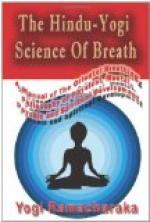A favorite Oriental method is to snuff a little water up the nostrils allowing it to run down the passage into the throat, from thence it may be ejected through the mouth. Some Hindu yogis immerse the face in a bowl of water, and by a sort of suction draw in quite a quantity of water, but this latter method requires considerable practice, and the first mentioned method is equally efficacious, and much more easily performed.
Another good plan is to open the window and breathe freely, closing one nostril with the finger or thumb, sniffing up the air through the open nostril. Then repeat the process on the other nostril. Repeat several times, changing nostrils. This method will usually clear the nostrils of obstructions.
In case the trouble is caused by catarrh it is well to apply a little vaseline or camphor ice or similar preparation. Or sniff up a little witch-hazel extract once in a while, and you will notice a marked improvement. A little care and attention will result in the nostrils becoming clean and remaining so.
We have given considerable space to this subject of nostril-breathing, not only because of its great importance in its reference to health, but because nostril-breathing is a prerequisite to the practice of the breathing exercises to be given later in this book, and because nostril-breathing is one of the basic principles underlying the Yogi Science of Breath.
We urge upon the student the necessity of acquiring this method of breathing if he has it not, and caution him against dismissing this phase of the subject as unimportant.
CHAPTER VII.
FOUR METHODS OF RESPIRATION.
In the consideration of the question of respiration, we must begin by considering the mechanical arrangements whereby the respiratory movements are effected. The mechanics of respiration manifest through (1) the elastic movements of the lungs, and (2) the activities of the sides and bottom of the thoracic cavity in which the lungs are contained. The thorax is that portion of the trunk between the neck and the abdomen, the cavity of which (known as the thoracic cavity) is occupied mainly by the lungs and heart. It is bounded by the spinal column, the ribs with their cartilages, the breastbone, and below by the diaphragm. It is generally spoken of as “the chest.” It has been compared to a completely shut, conical box, the small end of which Is turned upward, the back of the box being formed by the spinal column, the front by the breastbone and the sides by the ribs.
The ribs are twenty-four in number, twelve on each side, and emerge from each side of the spinal column. The upper seven pair are known as “true ribs,” being fastened to the breastbone direct, while the lower five pairs are called (false ribs) or “floating ribs,” because they are not so fastened, the upper two of them being fastened by cartilage to the other ribs, the remainder having no cartilages, their forward ends being free.




